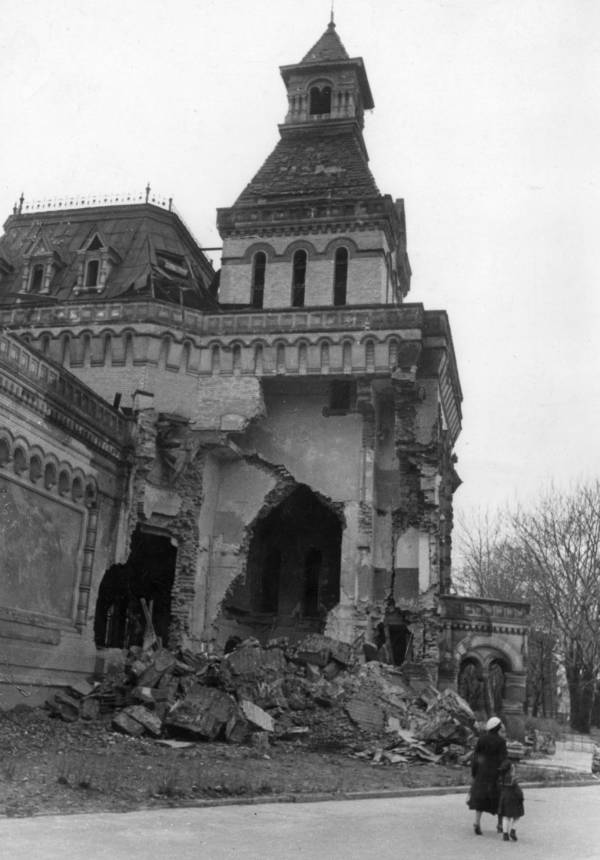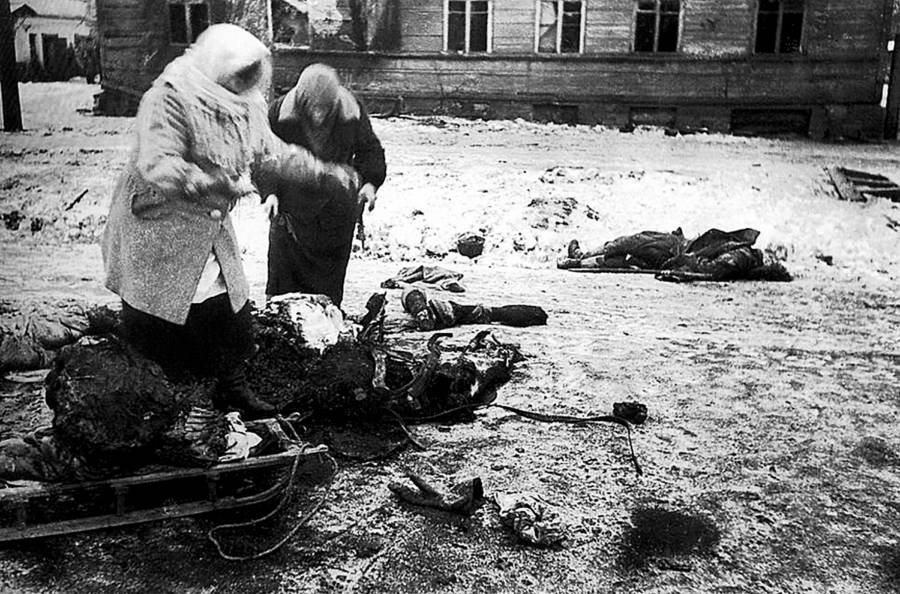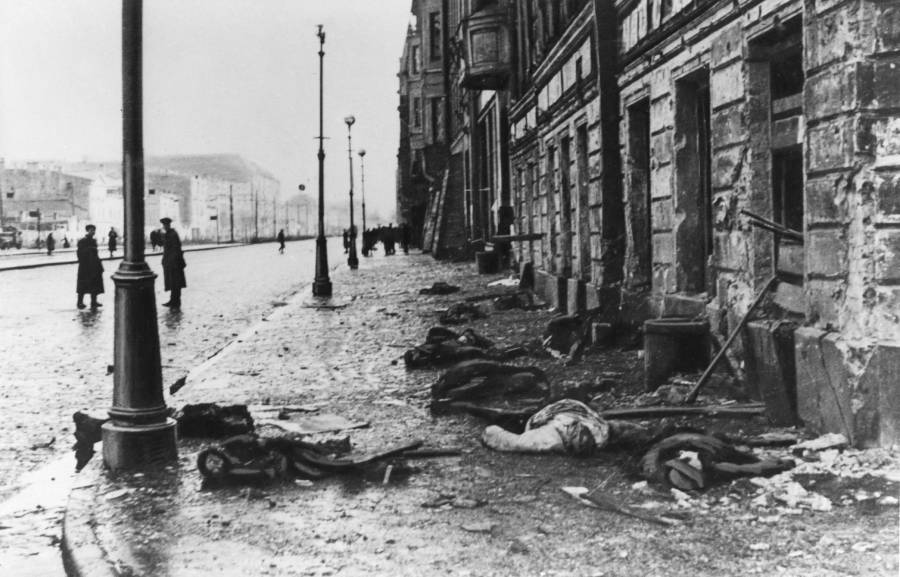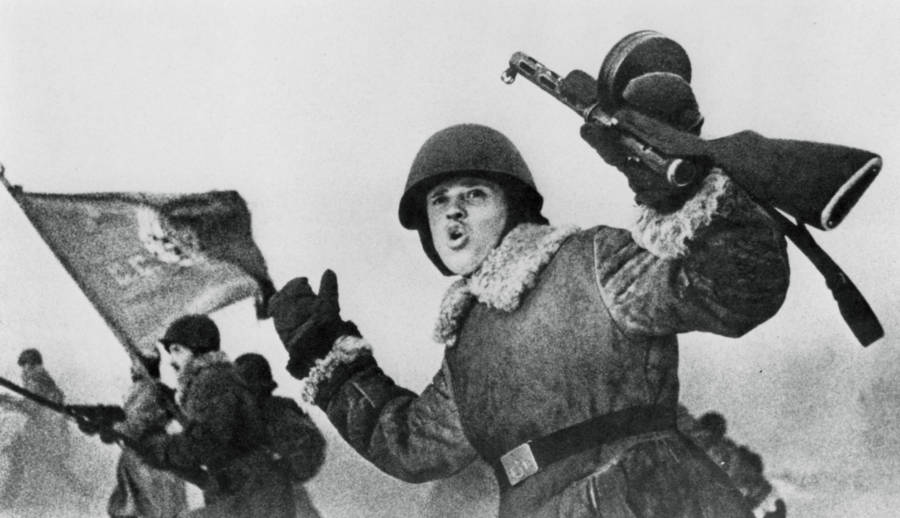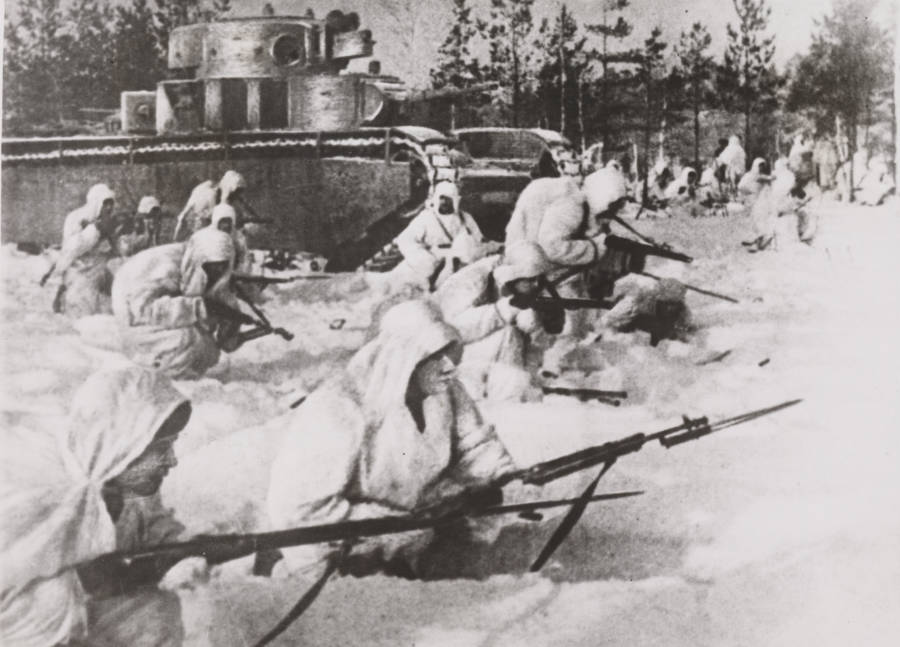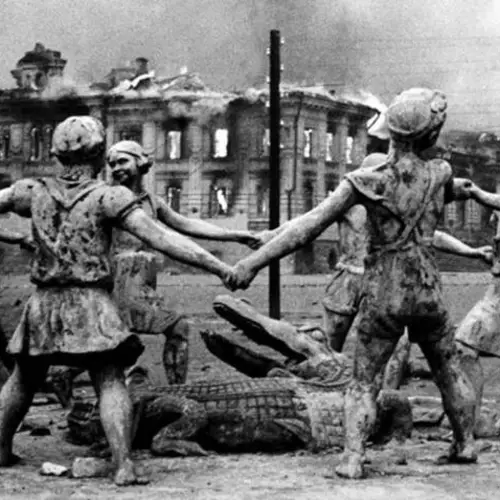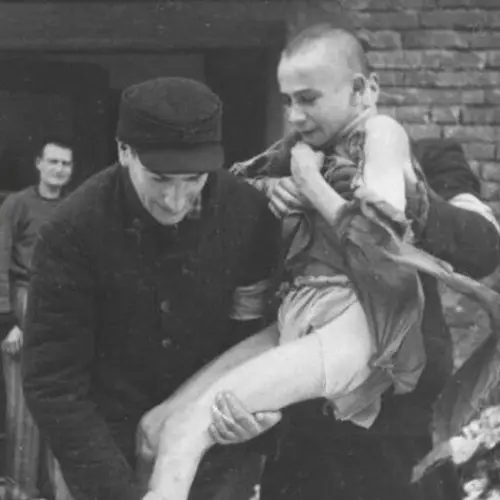2.5 million residents were reduced to just under 800,000 from starvation, disease, and exposure during the siege of Leningrad.
Known as the 900-day siege, the siege of Leningrad by Axis forces in World War II was one of the longest and most destructive blockades in world history, with some historians even classifying it as a genocide.
In total, roughly 1.5 million people were killed during the siege of Leningrad while some 1.4 million were evacuated. On Hitler's orders, the Soviet city suffered a daily barrage of artillery attacks from the German and Finnish forces that encircled it. The city's water and food supply were cut off and extreme famine soon set in.
The siege of Leningrad began on September 8, 1941, and ended after a grueling two-year period on January 27, 1944. After 872 days of starvation, disease, and psychological torment, the citizens of Leningrad were freed.
The Siege Of Leningrad

Berliner Verlag / Archiv/Picture Alliance/Getty ImagesSoviet forces march towards the front of the blockade.
After successfully taking France at the beginning of World War II, Adolf Hitler was eager to take on the Soviet Union. The Soviets still managed to hold on to their position in the East, largely in part because of the massive number of Red Army troops under their command, despite many of those army men being mostly untrained.
Hitler saw the Soviet's presence as nothing more than taking up Lebensraum, "living space" for the Germans. In order to defeat the Soviets, Hitler's military strategists came up with an all-out campaign to invade the Soviet Union, which came to be known as Operation Barbarossa, so-named for the Holy Roman Emperor Frederick I.
Roughly 80 percent of Germany's army was sent to partake in the invasion.
The strategy encompassed a far-reaching net of separate attacks of three different major Soviet areas: Leningrad in the north, Moscow in the center, and Ukraine in the south. Joseph Stalin's five million soldiers and 23,000 tanks were not prepared to face attack.
By the summer of 1941, 500,000 German soldiers had advanced toward the city of Leningrad. Under the command of General Field Marshall Wilhelm Ritter von Leeb, the German troops descended upon the Soviet's second-largest city.
But instead of taking it over, Adolf Hitler established a blockade around Leningrad, rendering it inaccessible to the outside world.
Leningrad's entire able-bodied population was mobilized to fortify the city's perimeter in support of Leningrad's remaining 200,000 Red Army defenders. Until their military could break through the German blockade, the citizens of Leningrad would have to wait.
The First Days In The 900-Day Siege
German troops were eager to conquer a Soviet city and so the order to siege Leningrad instead of burning it to the ground was met with protest. "The troops are shouting as one 'we want to march forward!'" Hitler's right-hand man Joseph Goebbels wrote in his diary.
Ultimately, all land communication in Leningrad was cut off as the city was bombarded with artillery attacks day in and day out. Germans continued their siege of Leningrad dutifully, and by August, the last railway which connected the city to the outside world was blocked.
There was only one opening out of the surrounded city and it went across the frozen Lake Ladoga. The ice road was little more than a death route, considering it was the only point through which where meager supplies and refugees could get — besides, it was constantly under German fire.
The lake route was officially called "Military Road No.101" but locals commonly referred to it as the "Street of Life." Some locals were eventually evacuated late into the siege of Leningrad through this route. However, that still left millions of Leningrad citizens inside the barricaded town to suffer.
Extreme Suffering And Starvation

TASS/Getty ImagesHorses transport supplies to Leningrad over the frozen Ladoga Lake, dubbed the "Street of Life."
After months held captive in their own homes, the people of Leningrad were overcome with severe starvation, poverty, and sickness. Within the first few weeks of the blockade, citizens began to die of starvation.
Food was strictly rationed and each resident received their share based on how essential they were to the city's defenses. Those most essential, such as soldiers and supply and factory workers, were allocated the most rations. The more vulnerable population including children, old people, and the unemployed were unfortunately not prioritized.
Those lowest in the ration system were entitled to 125 grams or three slices of bread every day. Bakeries used cellulose in their loaves to fatten up the bread, nonetheless, many residents were forced to survive on roughly 300 calories a day, which is less than a fifth of what an average-size adult's healthy intake should be.
The first winter after the siege of Leningrad was especially horrendous. Temperatures plummeted to -40 degrees Fahrenheit. Those who were lucky enough to have shelter, even without heat, would huddle with their family to keep warm. They burned furniture and then books. They were forced to sleep with their dead.
By midwinter of the siege of Leningrad, the combination of hunger and cold led to a growing number of corpses in the city's streets. During the government's spring clean-up operation, as many as 730 corpses were collected from a single hospital alone. To prevent the spread of disease, the city rallied locals to clear out the courtyards which were filled with all kinds of rubbish, feces, and bodies.
Desperation Leads To Cannibalism
Desperation during the siege of Leningrad brought many residents to do the unthinkable.
People deceived and stole from one another. Some, men and women alike, sold their bodies in exchange for food. Some people became so desperate that they even engaged in cannibalism.
Leningrad survivor and author Daniil Granin described how a mother fed her dead child to her surviving child to keep her alive: "A child died — he was just 3 years old. His mother laid the body inside the double-glazed window and sliced off a piece of him every day to feed her second child, a daughter. This is how she got her, though."
According to historian Guy Walters, there were two types of cannibalism: one was trupoedstvo, or eating the flesh of the dead, and the second type was liudoedstvo, which referred to the heinous act of eating the flesh of someone you killed purposefully to feed your own self. By some accounts, as many as 2,000 cases of cannibalism were recorded. Those caught in this act, however, were sentenced to immediate death.

Sovfoto/UIG/Getty ImagesResidents clearing snow and ice. The city declared a clean-up operation to prevent the spread of disease from scattered feces and unburied corpses.
Chaos And Crime
Alexis Peri, a professor at Boston University, compiled the diaries of survivors and interviewed them for her book The War Within: Diaries From the Siege of Leningrad. The accounts are disturbing.
"There are many scenes with a diarist confronting themselves in the mirror and being unable to recognize themselves," she wrote.
"It's the type of death that really creates that type of internal destabilization, as opposed to diaries that I've read from battle sites — the battles of Moscow and Stalingrad, where there's a very clear enemy and that enemy is an external one. With starvation, the enemy becomes internalized."
This internalization is plainly expressed in their journals. For instance, 17-year-old Elena Mukhina was so emaciated that she described her own reflection as the "old man" in the mirror, no longer "a young woman who has everything ahead of her."
Like Mukhina, the people who were able to survive became unrecognizable to themselves. Both boys and girls started growing facial hair because of extreme starvation; one diarist wrote of the bearded children, "We called them little old people."
Adults were no exception. Men became impotent while women lost the ability to menstruate and their breasts hardened and stopped producing milk. Ultimately, men and women became indistinguishable from one another as both had been rendered to walking corpses.
"Everyone is shriveled, their breasts sunken in, their stomachs enormous, and instead of arms and legs, just bones pole out through wrinkles," wrote Leningrader Aleksandra Liubovkaia.
The famine brought out the worst in people, too.
Many turned on their own families. There are stories of parents abandoning their children, spouses fighting over rations, and even accounts of theft and murder — all for a bite to eat.
Thirteen-year-old Valia Peterson wrote candidly about how she hated her stepfather because he stole her rations and ate her dog. "Hunger uncovered his filthy soul, and I have got to know him," she scribbled.
"One old woman, waiting for bread, slowly slides to the ground," wrote Russian ballerina Vera Kostrovitskaia. "But no one cares. Either she is already dead or she will be trampled to death." Kostrovitskaia then witnessed how residents in line for the daily rations began peeking at the woman's ration card to see if it had fallen out of her dead hand.
While thousands in the city starved, those in influential positions remained in good health. In fact, Soviet member Nikolai Ribkovskii recorded how during the siege he enjoyed caviar, turkey, goose, and ham. At one point he had to be admitted to the clinic because he had eaten so much.
By late summer 1942, evacuation and starvation had reduced Leningrad's population from 2.5 million to about 750,000. Most historians contend that the siege was in fact a genocide by starvation.
The End Of The Siege Of Leningrad

TASS/Getty ImagesTraffic regulator signals the supply route on Ladoga Lake.
In April 1942, the Soviet defense meant to breach the German blockade at the Leningrad front received a new commander, Lieutenant-General Leonid Govorov. The previous commander, Georgy Zhukov, had led the city's defenses and prevented the Germans from completely taking the city but had been sent by Joseph Stalin to defend the front lines in Moscow.
Although Govorov's leadership skills were not immediately apparent at the front during the siege of Leningrad, the soldiers came to respect his understated military brilliance nonetheless.
"In terms of leadership, Govorov was the complete opposite of a ruthless commander like Zhukov," Leningrad radio operator Mikhail Neishtadt noted. "He was a cultured, intelligent man, always concerned to save his soldiers' lives."
This concern paid off. On Jan. 12, 1944, the Soviet defenses finally punctured through the German encirclement and allowed more supplies to come in along icy Lake Ladoga. Finally, after 872 days of living in misery, the people of Leningrad were freed as the siege was lifted and the Germans were pushed west.
Crowds celebrated at the now freed city by drinking and dancing. There was even a display of fireworks.
"We brought out vodka," a teacher wrote of the victory celebrations. "We sang, cried and laughed. But it was sad all the same — the losses were just too big. A great work had ended, impossible deeds had been done, we all felt that... But we also felt confusion. How should we live now?"
The effects of the siege of Leningrad were so immense that they are still felt by the surviving families to this day.
Paying Tribute To The Survivors Of The Siege Of Leningrad
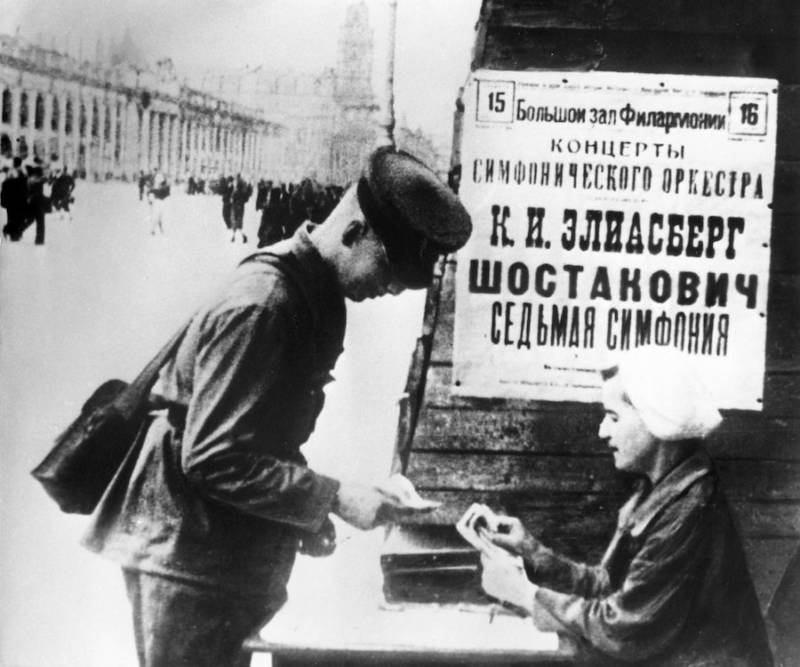
Sovfoto/UIG/Getty ImagesA Soviet soldier buys a ticket to the Symphony Concert in Leningrad.
Born in Leningrad after the war ended, Russian President Vladimir Putin was directly touched by the war's ravages. His older brother died as a child during the devastation and is buried at Piskaryovskoye where some half a million Leningraders were laid to rest in the cemetery's 186 mass graves.
Furthermore, Putin's mother almost died of starvation during the siege while his father fought and was wounded at the front lines of Leningrad.
"According to the enemy's plans, Leningrad should have disappeared from the face of the earth," Putin said during a memorial concert in honor of the Leningrad victims. "This is what is called a crime against humanity."
Today, there is an annual parade to commemorate the siege of Leningrad, but it has drawn both criticism and praise from modern-day Russians. Some think that the military parade is "beautiful" while others think that the money for it would be better spent on supporting the survivors.
A little over 100,000 military veterans and survivors of the siege of Leningrad still live in the former capital today.
Now that you've learned the history of the siege of Leningrad, read about the winter war's "Ghost Soldiers" who helped secure World War II for the Allies. Then, discover these bloody photos from the trenches of Verdun, modern history's longest battle.
